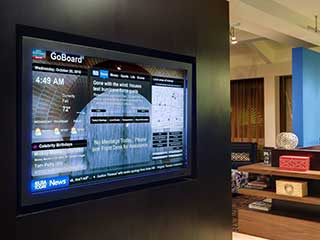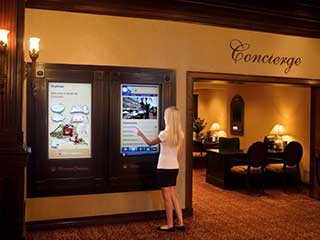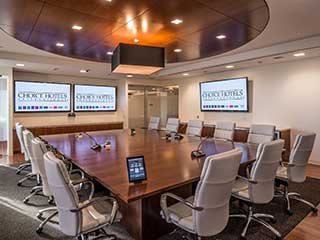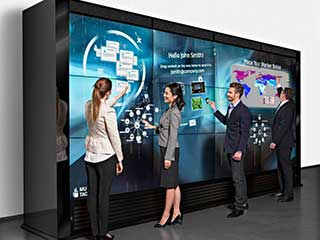Digital Hotel
Digital signage applications are spreading through every imaginable media. One of the most effective ways to facilitate communication with clients and guests is through digital signage. Naturally, hotels are trying to be among the first to modernize their services. And modernization today cannot be achieved without wide implementation of digital screen technologies.
That is exactly what hotels are trying to achieve by installing all sorts of digital screens from the lobby and the conference center to rooms. The screens are informing hotel guests and drawing them into the real hotel environments and virtual reality.
Every business wants the ability to communicate effectively with its customers. The personal communication with staff in modern hotels is nearly perfect, and non-verbal communication is only a developing trend that can be best achieved with the help of digital screens. In the 2017 Digital Signage Future Trends Report almost all participants who responded to a survey listed “improved customer service” and “increased customer engagement” as key benefits of digital signage.
 |
 |
The power of digital screen industry is on the rise. In 2016 alone the market stopped by shy of 20 billion dollars (19.6 as reported by the analytical research company “MarketsandMarkets”). It is expected to continue to grow to 33 billion by 2023 (which is compatible with the gross national product of such countries as Hong-Kong, Israel or Denmark). That’s a compound annual growth rate of 7.4 percent over that time, or significantly higher than the economic growth of major economies. Hotels are at the forefront of the digital signage revolution, and obviously hope to increase the visibility of hotel industry with the help of digital signage.
Specialists have long been talking of the ability of digital screens to catch people’s eyes, to providing concise and relevant information to clients. And modern travelers, or hotels’ clients, tend to believe that hotels must provide the amenities of modern technologies in addition to basic lodging and dining services. The 2015 research in several hotel chains found that 37 percent of hotel guests were at least moderately likely to choose a hotel with lobby technology, such as touchscreens and check-in kiosks, over one without. And that number continues to grow.
The hotel digital environment starts with the lobby. The contents on screens must be reasonably informational, mixing advertising with useful and entertainment content. Recently hotels started equipping lobbies with video walls that attract attention both by content and amazing quality (especially on new-age OLED screens). A modern traveler is always interested in new technological solutions that take your breath away, something that goes under the name “wow-factor”.
 |
 |
It is clear that conference halls and negotiating rooms in modern hotels must be saturated with digital screens, projectors and tablet solutions. Recently, the telephones started disappearing from the tables. They are frequently replaced by tablets that offer a multitude of functions, including digital contacts with hotel staff (for example, to order room service).
The rooms for guests are also becoming more and more digital. It is nice to enter the room and see your name with a welcoming message on the large flat screen in the middle of the room. Statistically, hotel guests watch TV 2-3 hours every day. But apart from regular TV programming, hotels offer special channels of virtual city tours and lists of outside entertainments. The high-speed Wi-Fi today is a necessity and the question is simply how reliable is the channel security, something that every hotel is trying to approach individually.
Since the launch of Facebook in 2004 and Twitter in 2006, along with a host of other applications, social media and networking has become an integral part of our lives. As such software developers see its integration into the signage medium as a logical step forward. Social media-enabled screens can serve a multitude of functions. Apart from social communication such integration serves the need for additional advertising and income generation for hotels.
Hotels are always surrounded by dozens of small enterprises. Digital signage offers an additional revenue stream through external advertisers who want to reach out to hotels’ customers and lure them outside the hotel. Through such partnerships, hotels can accept ads from those companies vying for business from travelers. Several surveys came to the conclusion that more than 54 percent of hospitality companies generate revenue by sharing deals from nearby merchants.
The role of digital media is growing day-by-day. And this concerns the hotel industry directly. Whether we talk of a small private B&B (Bed 'n Breakfast) or global hotel chains, the digital environment is becoming an inevitable part of our hotel experience. Digital screens become indispensable; they inform, assist and entertain.
The technologies today are developing very fast. The signage that is becoming commonplace was just a dream a few short years ago. What will happen in the digital hotel industry over the next several years is likely to be equally as futuristic.





